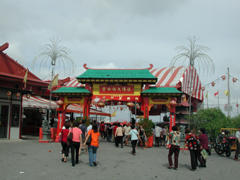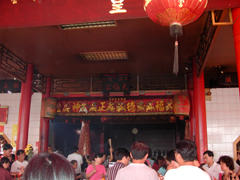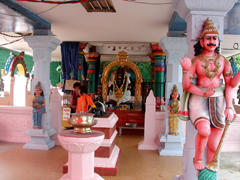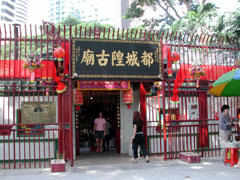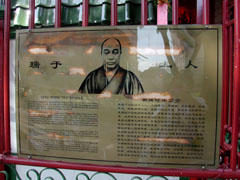
This is not a typical temple set-up found in most temples in Singapore where a devotee or any member of the public can walk in freely to pay homage. Instead, one has to be a member to be admitted into this “Sacred Union”. But on festive occasions such as the birthday of its patron saint, Confucius, one can see members of the public being welcomed into the temple premises.
The Union can trace its history to the 1930s when a group of immigrants from Foochow district in China pooled their resources to purchase a place to perform religious rites. That was how this building in River Valley Road came into their possession. There are actually 3 buildings in the Union - no. 251 for the worship of Goddess of Mercy; no. 253 – the central and main building - for Confucius; and no. 255 for Lao Tse.

Confucius is known, amongst other epithets, as the "uncrowned emperor of China" and the "throneless king" because of the vast impact of his teachings. The phoenix, which is a Chinese symbol of immortality and benevolence, is closely associated with him. The bird is reputed to have been sighted, along with the kirin (unicorn), at the time of Confucius' birth. It is believed that such auspicious sightings take place only before the birth of benevolent kings and sages. Lao Tse, founder of Taoism, associated Confucius with the phoenix because of the latter's teachings which emphasises benevolence and virtue. Legend has it that the phoenix carries sacred scrolls and/or holy books in its bill. For these reasons, Confucius is deeply revered by members of the Nanyang Sacred Union.
Union membership is exclusive. To be a member, the prospective candidate not only has to be recommended by an existing member, but must also seek sanction from Confucius by picking either a “yes” or a “no” slip of paper tossed before the deity. A “yes” would of course signify acceptance. It was said that one devoted fellow got in only on the 8th try!
The Union currently has 1,500 members, male and female, from all walks of life. Membership has its privileges - apart from being able to network among like-minded individuals, members can secure a place for their ancestral tablets directly behind the statue of Confucius, the paragon of filial piety.

The main event held every year in the temple is the religious ceremony performed to honour Confucius on his birthday. This usually falls in October. The ceremony is conducted in the Foochow dialect. Majority of the participants - about a dozen – tend to be elderly men, 60 years and above. All participants would wear a black cap on their head and a black tunic over a long blue shirt that touches the ankles. The ceremony involves a lot of bowing and praying, first to the Jade Emperor and then to Confucius.
Even the placing of offerings on Confucius’ altar has to be painstakingly carried out. Again this entails a lot of bowing to each other as the offerings are handed by one men to the next, on cue.

The fruits offered have to be of five colours - white (pomelo); black (purple grapes); red (apple); green (pear) and orange (orange). There will also be five types of dishes offered - three meat and two seafood dishes. Other offerings take the form of rice, tea, fragrance, cloth, rosary beads and Chinese coins
When all are placed properly on the altar, the men will then recite in unison by referring to the Chinese text held in front of them. All in, the ceremony will last an hour-and-a-half. The attention to detail and the meticulously-orchestrated movements all bear testimony to Confucius’ emphasis on orderliness and proper conduct which one can well appreciate given that Confucius lived during the turbulent period of the Warring States. There are about ten such Unions spread all over Malaysia - the headquarters being this one in Singapore.
Details:
Nanyang Sacred Union
231-235 River Valley Road
Singapore 238289
Tel: 6737 2985; 6235 5975
Ack: taoism-singapore@yahoogroups.com

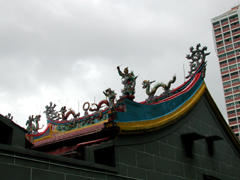 Emperor. On the eve of the 9th day of the Chinese Lunar New Year (1st Lunar Month) - the birthday of the Jade Emperor, this temple is one place where many Taoist devotees would come to pay their respects.
Emperor. On the eve of the 9th day of the Chinese Lunar New Year (1st Lunar Month) - the birthday of the Jade Emperor, this temple is one place where many Taoist devotees would come to pay their respects.




